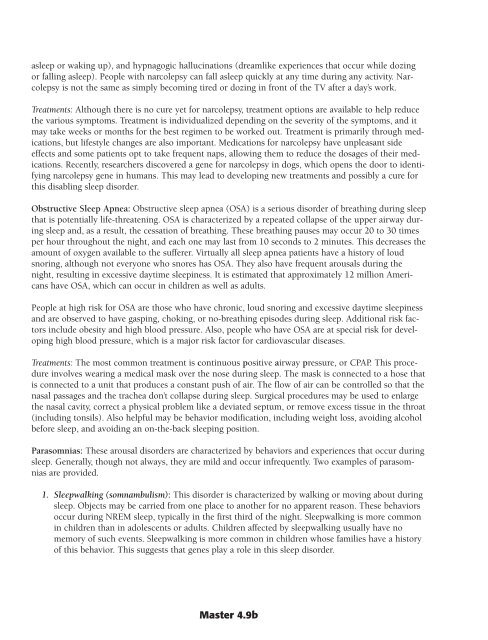Biological - NIH Office of Science Education - National Institutes of ...
Biological - NIH Office of Science Education - National Institutes of ...
Biological - NIH Office of Science Education - National Institutes of ...
Create successful ePaper yourself
Turn your PDF publications into a flip-book with our unique Google optimized e-Paper software.
asleep or waking up), and hypnagogic hallucinations (dreamlike experiences that occur while dozing<br />
or falling asleep). People with narcolepsy can fall asleep quickly at any time during any activity. Narcolepsy<br />
is not the same as simply becoming tired or dozing in front <strong>of</strong> the TV after a day’s work.<br />
Treatments: Although there is no cure yet for narcolepsy, treatment options are available to help reduce<br />
the various symptoms. Treatment is individualized depending on the severity <strong>of</strong> the symptoms, and it<br />
may take weeks or months for the best regimen to be worked out. Treatment is primarily through medications,<br />
but lifestyle changes are also important. Medications for narcolepsy have unpleasant side<br />
effects and some patients opt to take frequent naps, allowing them to reduce the dosages <strong>of</strong> their medications.<br />
Recently, researchers discovered a gene for narcolepsy in dogs, which opens the door to identifying<br />
narcolepsy gene in humans. This may lead to developing new treatments and possibly a cure for<br />
this disabling sleep disorder.<br />
Obstructive Sleep Apnea: Obstructive sleep apnea (OSA) is a serious disorder <strong>of</strong> breathing during sleep<br />
that is potentially life-threatening. OSA is characterized by a repeated collapse <strong>of</strong> the upper airway during<br />
sleep and, as a result, the cessation <strong>of</strong> breathing. These breathing pauses may occur 20 to 30 times<br />
per hour throughout the night, and each one may last from 10 seconds to 2 minutes. This decreases the<br />
amount <strong>of</strong> oxygen available to the sufferer. Virtually all sleep apnea patients have a history <strong>of</strong> loud<br />
snoring, although not everyone who snores has OSA. They also have frequent arousals during the<br />
night, resulting in excessive daytime sleepiness. It is estimated that approximately 12 million Americans<br />
have OSA, which can occur in children as well as adults.<br />
People at high risk for OSA are those who have chronic, loud snoring and excessive daytime sleepiness<br />
and are observed to have gasping, choking, or no-breathing episodes during sleep. Additional risk factors<br />
include obesity and high blood pressure. Also, people who have OSA are at special risk for developing<br />
high blood pressure, which is a major risk factor for cardiovascular diseases.<br />
Treatments: The most common treatment is continuous positive airway pressure, or CPAP. This procedure<br />
involves wearing a medical mask over the nose during sleep. The mask is connected to a hose that<br />
is connected to a unit that produces a constant push <strong>of</strong> air. The flow <strong>of</strong> air can be controlled so that the<br />
nasal passages and the trachea don’t collapse during sleep. Surgical procedures may be used to enlarge<br />
the nasal cavity, correct a physical problem like a deviated septum, or remove excess tissue in the throat<br />
(including tonsils). Also helpful may be behavior modification, including weight loss, avoiding alcohol<br />
before sleep, and avoiding an on-the-back sleeping position.<br />
Parasomnias: These arousal disorders are characterized by behaviors and experiences that occur during<br />
sleep. Generally, though not always, they are mild and occur infrequently. Two examples <strong>of</strong> parasomnias<br />
are provided.<br />
1. Sleepwalking (somnambulism): This disorder is characterized by walking or moving about during<br />
sleep. Objects may be carried from one place to another for no apparent reason. These behaviors<br />
occur during NREM sleep, typically in the first third <strong>of</strong> the night. Sleepwalking is more common<br />
in children than in adolescents or adults. Children affected by sleepwalking usually have no<br />
memory <strong>of</strong> such events. Sleepwalking is more common in children whose families have a history<br />
<strong>of</strong> this behavior. This suggests that genes play a role in this sleep disorder.<br />
Master 4.9b

















